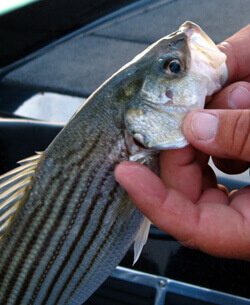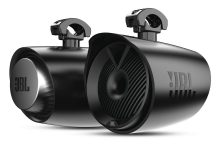No Shortage Of Stripers
No Shortage Of Stripers; Catch ‘Em At First Light

STRIPER STRATEGIES — As John Anderson says, most fishermen looking for stripers are on the water at first light. He suggests topwater bails, shad patterns, and clear baits with just a bit of blue or silver on the back.
By John Anderson
AZ Angling Editor
How would you like to catch 20, 30, even 50 fish during the first hour of daylight? That’s always a possibility with stripers. Striped bass, or stripers, started being stocked in western waters in the mid ’50s, and since then, they’ve shown an ability to adapt to inland waters that has made them one of the most prolific of game fish.
Most striper fishermen like being on the water at first light. For a half hour to an hour, cruise the main channel and watch for boils. When you spot one, get over there quickly and throw topwater baits. Stick baits like Super Spooks, Rebel Jumping Minnows, and big Sammy’s are excellent. Shad patterns are good, and so are clear baits with a touch of blue or silver on the back.
If You Miss First Light
If you miss first light, or somehow get turned around and can’t find the areas where the boils are happening, all is not lost. Find a nice, deep bluff, maybe with a rock slide on it, and fish some bait in the shade at 30 to 50 feet deep. If you can see fish on the graph at that depth, it’s most likely stripers. You can put anchovies on a circle hook and offer them to the suspended stripers.
Whether you use spinning gear or baitcasting, make sure your rod and reel are capable of handling fish of 20 pounds or more. With the baits on circle hooks, you’ll feel the pressure when a striper takes it and you should use a sweep set rather than a jerk. On the topwater lures, your problem is more likely to be keeping yourself from setting the hook until you feel the fish. If you just watch, you’ll see your lure getting slapped around and you’ll be constantly trying to take it away from the fish.
Old Ideas Are False
Many of the old ideas about striper survival and reproduction have been proven false in recent years. For instance, it was once thought that stripers had to have 40 miles or so of flowing river for successful reproduction. Striped bass spawn in current, and moving water is necessary to keep both eggs and fry from settling to the bottom and being covered by silt. However, in places like Lake Pleasant and Lake Powell, stripers have been able to find enough clean gravel and current from springs or wave action to have a successful spawn without the benefit of miles of river current.
This ability to adapt has made the striper an unpopular fish at times. Explosions of striper populations can have a detrimental effect on other game fish populations, especially in waters that aren’t very fertile to begin with. Stripers have a high metabolism that requires a lot of food, so a huge population of hungry striped bass can devastate the shad population that they and other game fish rely on. The result can be decreases in numbers of largemouth and smallmouth bass, crappie, and other fish that feed on shad. This is one reason for the liberal striper limits in Arizona.
Trolling Tricks
Trolling for summer stripers later in the season is one of the best ways to get the deep fish. Lures that imitate shad usually work best — try Rapalas, Rebels, Thinfins, and spoons. To get the lures down deep, some anglers tie on a deep-diving lure like a Hellbender, and then attach another lure to it with a leader. Others use lead core line to troll deep.
Trolling and spooning is another way to catch stripers, especially once they’ve moved deep. Start out early in the morning, and target long points in the main lake. Try fishing across the points, trying different angles until you start getting bit.
At Lake Pleasant, try the areas just leading into the big bays and the river. Cruise along and look for fish on your graph. The stripers tend to move around a lot, so you might be able to drift along and spoon a bunch of them for a few minutes, and then they’ll be gone. Big silver slab spoons are perfect.
“You have to change the split rings on the spoons,” says New Mexico striper guide Dale Wagy, “because big stripers destroy them. I use 3/4-ounce Strada spoons with salt-water rings and extra heavy duty VMC hooks, size one.” Wagy jigs the spoons vertically, bumping the bottom, and then fishing with a jerk-and-stop action. He always fishes artificial lures on a flippin’ stick when he’s out for stripers, and he uses 25-pound-test line spooled onto an Abu Garcia 4600C reel. If he starts to run out of line, he says, he just follows the fish with the boat.
When Stripers Are Deep
When stripers are deep, Wagy also has good luck with down lines. He stresses the need for heavy rods and big reels that hold lots of line. Wagy uses 20-pound-test Stren Super Tough and 1/0 to 3/0 kahle hooks, matching the hook to the size of the shad he’s using. “You have to catch your own shad,” he emphasizes, “they’re hard to keep alive, so no one sells them.” He never uses cut bait or frozen bait, because he’s noticed that live bait catches bigger fish.
Wagy uses a 2-ounce egg sinker, a heavy duty swivel, and a 4- to 5-foot leader. “Whether you hold the rod or put it in a rod holder, just let the line straight down to where the fish are,” he says. “I use my X-70 to look for stripers or baitfish. A lot of times, all you’ll see are huge clouds of baitfish.” Once you get your bait down, says Wagy, just sit still or troll very slowly. When the stripers hit, they’ll pull your rod tip clear down to the water’s surface. Wagy often runs several lines at different depths until he starts catching fish.
These striper techniques will work just about anyplace where stripers live, and in Arizona that means the Colorado River waters and Lake Pleasant. At Pleasant, big stripers started showing up within years of the CAP waters flowing in, and now they are abundant. Trolling near the dam is popular, but you can also find boils in the river end. Sometimes those boils will turn out to be white bass, though.
Italian Dressing, Batter, And Fry
Stripers are as good on the plate as they are on the line, especially if you soak them in Italian dressing for a while before you batter and fry them. Remove the red meat before you soak them, and make sure you keep them good and cold after you catch them. Bring an ice chest with plenty of ice because your livewell probably isn’t big enough for a mess of stripers, and you’ll be going home with a bunch of them this time of year.































